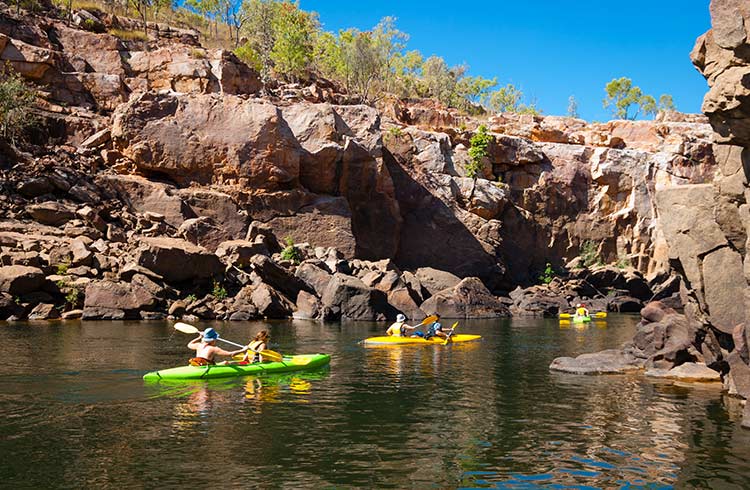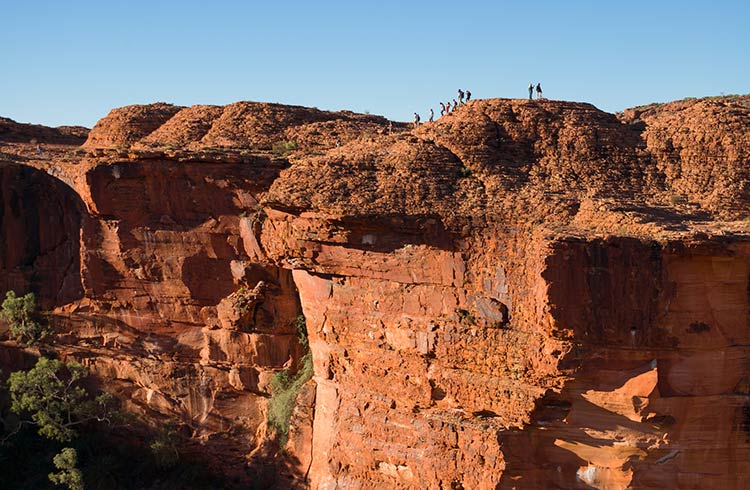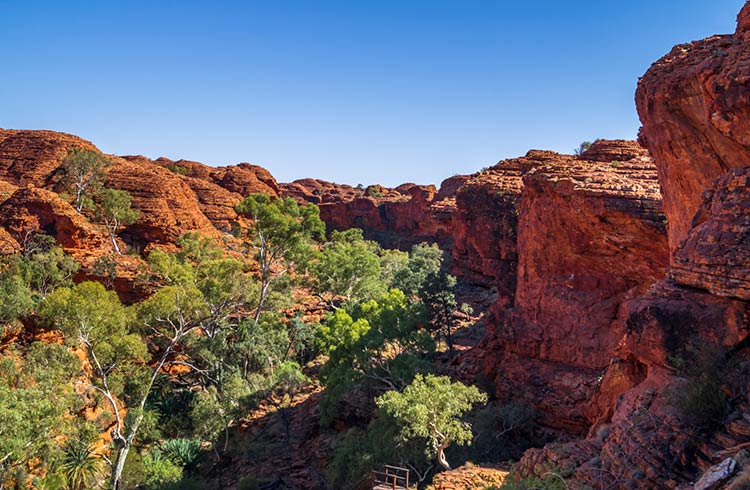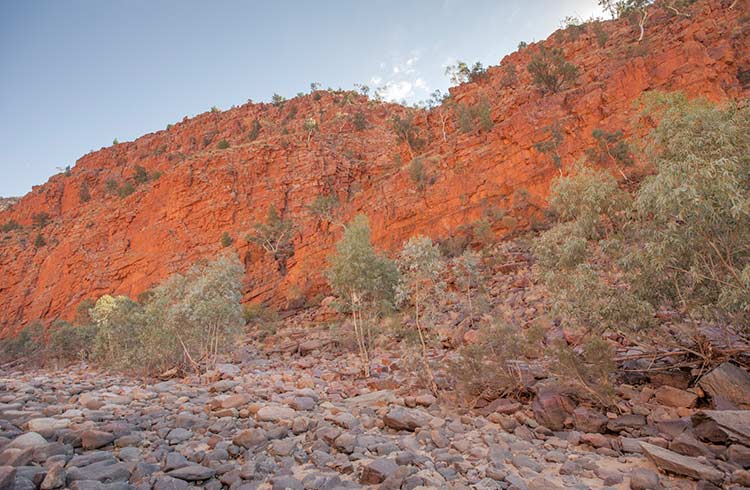Reading time: 5 minutes

None of us could have imagined the unprecedented events that have unfolded in recent months. For most of us, travel is now paused but that doesn't mean dreaming and planning should be put on hold. Here is some inspiration for when we can travel again.
The Northern Territory (NT) is home to incredible native wildlife, beautiful national parks, and a rich Indigenous history and culture. From Kakadu to Uluru, Katelyn Michaud tells us how to explore the Northern Territory beyond Australia's most iconic landmarks.
A version of Discover the NT Beyond Australia's Famous Landmarks first appeared on WorldNomads.com.
 Photo © Getty Images/Whitworth Images
Photo © Getty Images/Whitworth Images
- Uluru
- Kata Tjuta
- Watarrka National Park
- Nitmiluk National Park
- Kakadu National Park
- Day Hikes in the Northern Territory
- Multi Day Hikes in the Northern Territory
- Road Trip Itineraries
- Food in the Northern Territory
- Culture in the Northern Territory
- Planning Your Trip Around the Northern Territory
Uluru
Situated in the heart of the so-called Red Centre, Uluru is one of the great natural wonders of the world, rising 1,141ft (348m) out of the desert. Uluru is an important spiritual place for the local Anangu people, who are the traditional owners of Uluru. Visitors are asked not to climb the rock as the path follows the same walked by initiated senior indigenous men, the Mala. An official climbing ban comes into effect in October 2019 out of respect to local custom. The climb is also incredibly dangerous and has resulted in the deaths of more than 30 people. For a much better appreciation of the famous monolith, take the 6.2mi (10km) Uluru Base Walk, or wake up early a catch a colourful sunrise from Dune Walk Lookout.
Kata Tjuta
A 45-minute drive away, Kata Tjuta is a 36-dome rock formation that is as beautiful as Uluru but has fewer crowds. The Valley of the Winds walk winds through the heart of Kata Tjuta offers incredible views of the ancient landscape. There are many Dreamtime legends associated with Kata Tjuta, but the most shared story is about the great snake king, Wanambi, who is said to live on the summit of Kata Tjuta. Many of the traditional stories of the Anangu are not shared with outsiders as is customary.
Watarrka National Park
Take a three-hour drive north of Uluru to Kings Canyon in Watarrka National Park. Lace up your hiking boots and discover the natural beauty of the 328ft (100m) sandstone walls of the canyon on the 3.7mi (6km) Rim Walk. The Rim Walk starts with a difficult climb uphill before you reach the top of the canyon. Halfway along, stop to see (swimming isn't allowed) the waterhole surrounded by rare plants in the "Garden of Eden", and walk in the shade of ancient palms that dot the length of the trail.
 The dramatic landscapes of Kings Canyon, Northern Territory. Photo credit: Getty Images/Westend61
The dramatic landscapes of Kings Canyon, Northern Territory. Photo credit: Getty Images/Westend61
Nitmiluk National Park
Home to Katherine Gorge, Nitmiluk National Park belongs to the Jawoyn and Dagomen people. Throughout the 13 gorges, there are many Indigenous rock paintings on the sandstone walls featuring x-ray style art. Hire a canoe to see them on the canyon walls, or cool off with a dip at Leliyn (Edith Falls). To break up the long drive from Alice Springs to Darwin, stop at Mataranka Thermal Springs for a relaxing swim in the warm spring waters.
 Canoeing or kayaking in Katherine Gorge. Photo credit: Getty Images/Whitworth Images
Canoeing or kayaking in Katherine Gorge. Photo credit: Getty Images/Whitworth Images
Kakadu National Park
Covering more than 7,722mi2 (20,000km2) the World Heritage site of Kakadu National Park is considered one of the best national parks in the world. With incredible biodiversity, Kakadu is filled with wildlife and dramatic rugged landscapes. Search for crocodiles and birds in Corroboree Billabong, watch the sunset in Ubirr, and take a dip in nature's infinity pool at Gunlom Falls.
The Bininj and Mungguy people have lived in Kakadu for more than 50,000 years, and the local rock art is some of the best in the country. Nourlangie is home to the famous Lightning Man Creation Ancestor where you'll see lots of hand art, figures hunting, and more. Look for the Tasmanian tiger at Ubirr, where the smooth stone surfaces were perfect for painting. For even more waterfalls and giant termite mounds, visit Litchfield National Park, just south of Darwin.
Day Hikes in the Northern Territory
The NT offers an abundance of hiking trails just waiting to be discovered, from classic walks at Uluru and Kings Canyon in the Red Center to Aboriginal art walks in Kakadu National Park. The 7.4mi (12km) Barrk Sandstone Walk through Nourlangie Rock in Kakadu National Park offers access to some of the best rock art in the park.
On a humid day in Litchfield National Park, the Florence Creek Walk is a great way to cool off. Splash in the rock pools of Buley Rockhole before walking the 1.9mi (3.2km) trail to Florence Falls for a swim under the waterfall.
Multi-Day Hikes in the Northern Territory
Jatbula Trail in Nitmiluk (Katherine) National Park is 36mi (58km) long and starts at the visitor center and ends at Leliyn. The trail passes by ancient Aboriginal rock art, waterfalls, monsoon rainforest, and takes about four days. The trek can be completed with or without a guide, and you should expect to carry all your equipment and food, walking approximately 6–10mi (10–17km) a day.
The Larapinta Trail near Alice Springs is 138.5mi (223km) long, and winds through the West MacDonnell Ranges, and typically takes 12 days to complete. Due to the intense heat, the best time of year to walk the trail is between May and August. If you don't have time to hike the trail in its entirety, many people choose to hike small sections in a day or over a weekend. The trail is challenging and remote, so you need to be prepared with the right equipment, water, and food.
 Ormiston Gorge is part of the Larapinta Trail. Photo credit: Getty Images/Bryce Thomas
Ormiston Gorge is part of the Larapinta Trail. Photo credit: Getty Images/Bryce Thomas
Road Trip Itineraries
Driving the Northern Territory from Alice Springs to Darwin via the Stuart Highway is one of the classic Northern Territory road trips, and will take you from the red dirt of the desert to the coral reefs in the Arafura Sea. There are plenty of places to stop along the 932mi (1,500km) route to break up the drive, including Karlu Karlu (Devils Marbles), Daly Waters Pub, and Katherine Gorge.
Take the long way to Uluru from Alice Springs and visit Kings Canyon, Kata Tjuta, and Finke Gorge National Park, where the Finke River, one of the oldest waterways in the world, flows. Peer into Tnorala (Gosse Bluff), a comet crater that's more than 140 million years old.
Driving the Savannah Way, from Cairns to Broome, is one of Australia's most epic road trip routes. Drive the 2,175mi (3,501km), to see the best the Australian Outback has to offer. If you're driving a 4WD, you can explore remote parts of the Outback, see the sandstone spires in Cape Crawford before visiting Borroloola, one of Australia's most remote towns, which is also home to excellent fishing. On the other side of Katherine, Flora River Nature Park is one of the best barramundi fishing destinations in the NT. Catch your dinner and roast it over a campfire under the stars.
Food in the Northern Territory
From a pub meal in the Outback to Asian dishes in Darwin, a wide range of food is on offer around the Northern Territory. Mindil Beach Sunset Market in Darwin is a great place to sample food from around the world, such as crepes, kebabs, Indian dishes, and more. Daly Waters Pub first opened in 1930 and is one of the most famous stops along the Stuart Highway. While you're there, try the Barramundi sandwich.
Check the menu carefully if you're looking for something uniquely Australian, as many restaurants around the state also serve meat from crocodiles, camels, emus, and kangaroos. Kangaroo is very rich and lean, best cooked medium-rare, while crocodile meat is very pale and tastes like chicken. Camel and emu meat taste similar to beef and is best eaten on a burger.
Culture in the Northern Territory
Alice Springs is the cultural hub of the Red Center. Just outside of town, you'll find the Alice Springs Telegraph Station that was established in 1871 to relay telegraph messages from Darwin to Adelaide. Downtown, you'll find incredible Aboriginal art in many of the art galleries in Todd Mall and the Araluen Galleries. Before buying any art, ensure the dealer follows the Indigenous art code or buy directly from the artist at a community art center.
Located 62mi (100km) offshore from Darwin, the Tiwi Islands are home to the Tiwi people. Tours leave from Darwin by plane or ferry and include morning tea with the Tiwi women, a stop at a Tiwi burial site, and a traditional smoking ceremony. Smoking ceremonies are performed by the women of the community to bless their visitors.
Planning Your Trip Around the Northern Territory
Driving in the Northern Territory is both exciting and nerve-wracking. With long distances between petrol stations, it's critical to carry jerry cans with fuel for remote road trips. Always stop and top off your fuel tank at every petrol station, as the next stop could be hundreds of miles away, and mobile reception is spotty in the Outback. Unless you have a four-wheel drive vehicle, stick to the highways.
During the wet season, flooding is a major concern and happens often. When it floods, saltwater crocodiles can travel hundreds of miles inland to freshwater lakes and rivers. Always be mindful of crocodile signs, and when in doubt, don't swim in the water.
The Northern Territory is hot and humid. Always wear sunscreen and a hat to protect your skin from the strong Australian sun, and drink lots of water to stay hydrated.